Testing The World’s Best APUs: Desktop AMD Ryzen 4750G, 4650G and 4350G
by Dr. Ian Cutress on December 16, 2020 10:30 AM ESTCPU Benchmarks: Real World
All of our benchmark results can also be found in our benchmark engine, Bench.
Agisoft Photoscan 1.3.3: link
The concept of Photoscan is about translating many 2D images into a 3D model - so the more detailed the images, and the more you have, the better the final 3D model in both spatial accuracy and texturing accuracy. The algorithm has four stages, with some parts of the stages being single-threaded and others multi-threaded, along with some cache/memory dependency in there as well. For some of the more variable threaded workload, features such as Speed Shift and XFR will be able to take advantage of CPU stalls or downtime, giving sizeable speedups on newer microarchitectures.
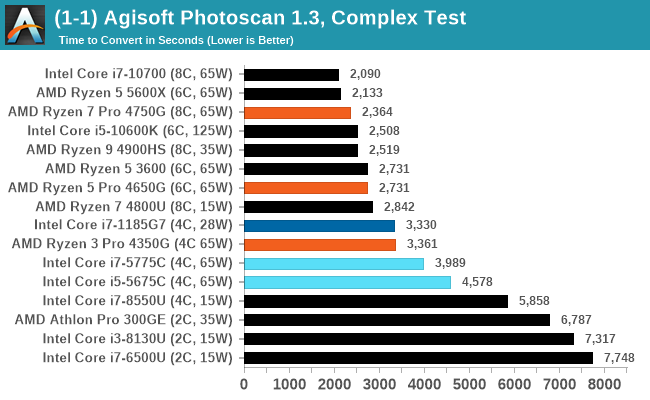
NAMD 2.13 (ApoA1): Molecular Dynamics
One of the popular science fields is modeling the dynamics of proteins. By looking at how the energy of active sites within a large protein structure over time, scientists behind the research can calculate required activation energies for potential interactions. This becomes very important in drug discovery. Molecular dynamics also plays a large role in protein folding, and in understanding what happens when proteins misfold, and what can be done to prevent it. NAMD, or Nanoscale Molecular Dynamics, has already been used in extensive Coronavirus research on the Frontier supercomputer. Typical simulations using the package are measured in how many nanoseconds per day can be calculated with the given hardware, and the ApoA1 protein (92,224 atoms) has been the standard model for molecular dynamics simulation.
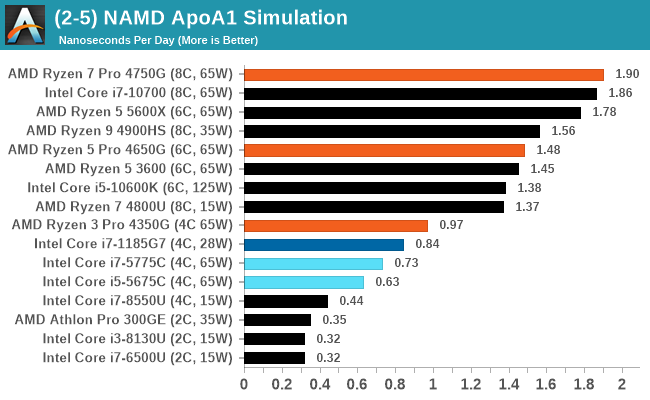
Blender 2.83 LTS: Link
One of the popular tools for rendering is Blender, with it being a public open source project that anyone in the animation industry can get involved in. This extends to conferences, use in films and VR, with a dedicated Blender Institute, and everything you might expect from a professional software package (except perhaps a professional grade support package). With it being open-source, studios can customize it in as many ways as they need to get the results they require. It ends up being a big optimization target for both Intel and AMD in this regard.
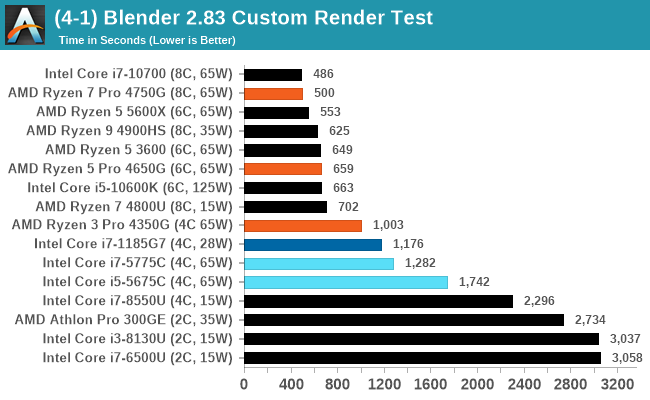
Corona 1.3: Link
Corona is billed as a popular high-performance photorealistic rendering engine for 3ds Max, with development for Cinema 4D support as well. In order to promote the software, the developers produced a downloadable benchmark on the 1.3 version of the software, with a ray-traced scene involving a military vehicle and a lot of foliage.
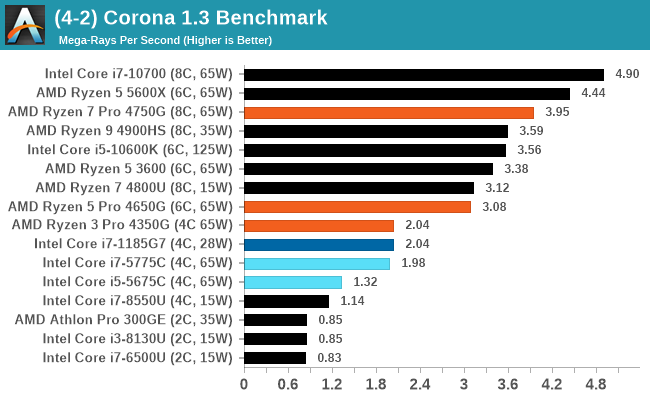
POV-Ray 3.7.1: Link
A long time benchmark staple, POV-Ray is another rendering program that is well known to load up every single thread in a system, regardless of cache and memory levels. After a long period of POV-Ray 3.7 being the latest official release, when AMD launched Ryzen the POV-Ray codebase suddenly saw a range of activity from both AMD and Intel, knowing that the software (with the built-in benchmark) would be an optimization tool for the hardware.
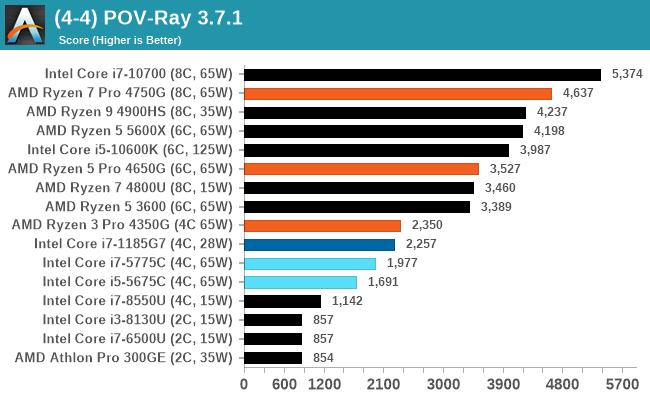
V-Ray: Link
We have a couple of renderers and ray tracers in our suite already, however V-Ray’s benchmark came through for a requested benchmark enough for us to roll it in. Built by ChaosGroup, V-Ray is a 3D rendering package compatible with a number of popular commercial imaging applications, such as 3ds Max, Maya, Undreal, Cinema 4D, and Blender.
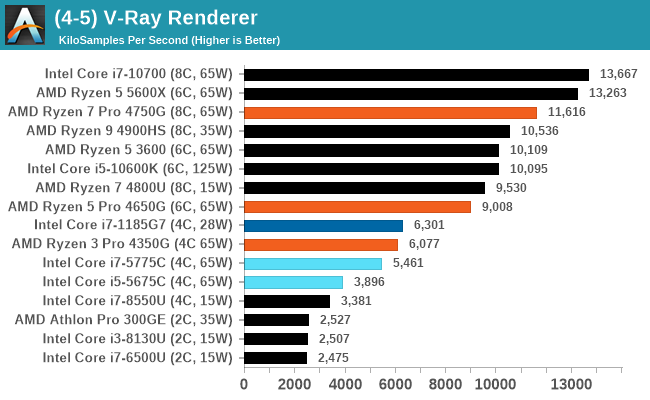
HandBrake 1.32: Link
Handbrake is a favored tool for transcoding, with the later versions using copious amounts of newer APIs to take advantage of co-processors, like GPUs. It is available on Windows via an interface or can be accessed through the command-line, with the latter making our testing easier, with a redirection operator for the console output. We take the compiled version of this 16-minute YouTube video about Russian CPUs at 1080p30 h264 and convert into a 480p30 ‘Discord’ format.
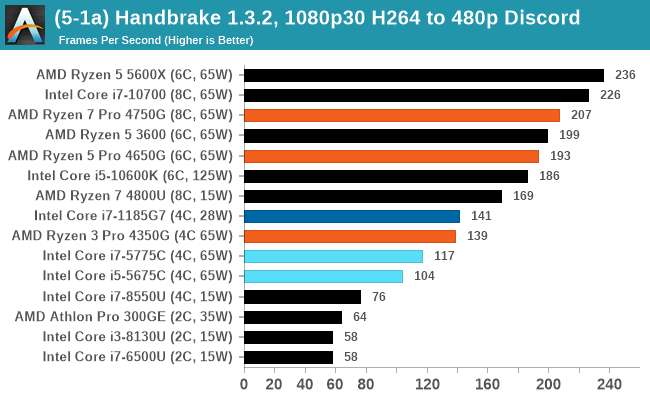
7-Zip 1900: Link
The first compression benchmark tool we use is the open-source 7-zip, which typically offers good scaling across multiple cores. 7-zip is the compression tool most cited by readers as one they would rather see benchmarks on, and the program includes a built-in benchmark tool for both compression and decompression.
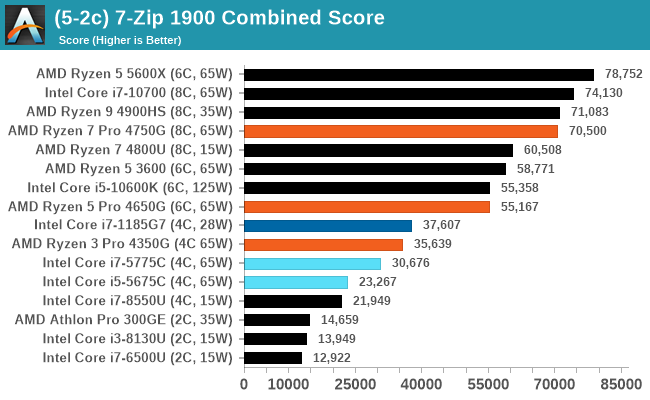
AES Encoding
Algorithms using AES coding have spread far and wide as a ubiquitous tool for encryption. Again, this is another CPU limited test, and modern CPUs have special AES pathways to accelerate their performance. We often see scaling in both frequency and cores with this benchmark. We use the latest version of TrueCrypt and run its benchmark mode over 1GB of in-DRAM data. Results shown are the GB/s average of encryption and decryption.
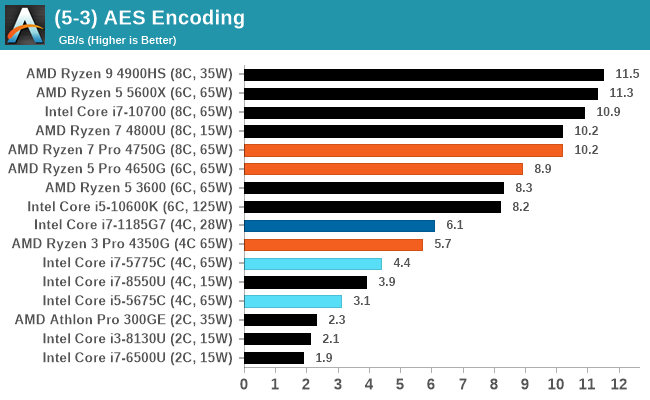
WinRAR 5.90: Link
For the 2020 test suite, we move to the latest version of WinRAR in our compression test. WinRAR in some quarters is more user friendly that 7-Zip, hence its inclusion. Rather than use a benchmark mode as we did with 7-Zip, here we take a set of files representative of a generic stack – a micture mixture of compressible and incompressible formats
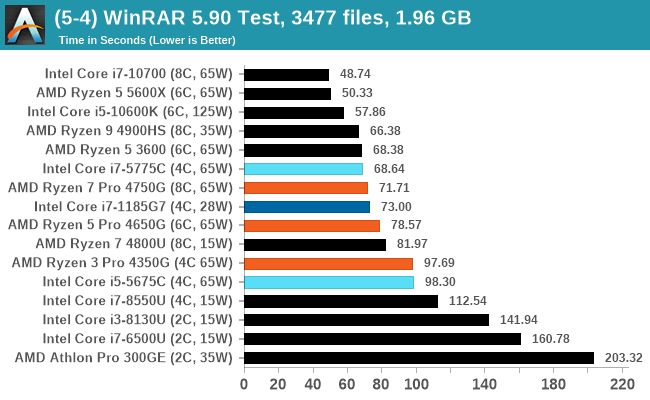
Mozilla Kraken 1.1
Kraken is a 2010 benchmark from Mozilla and does a series of JavaScript tests. These tests are a little more involved than previous tests, looking at artificial intelligence, audio manipulation, image manipulation, json parsing, and cryptographic functions. The benchmark starts with an initial download of data for the audio and imaging, and then runs through 10 times giving a timed result.
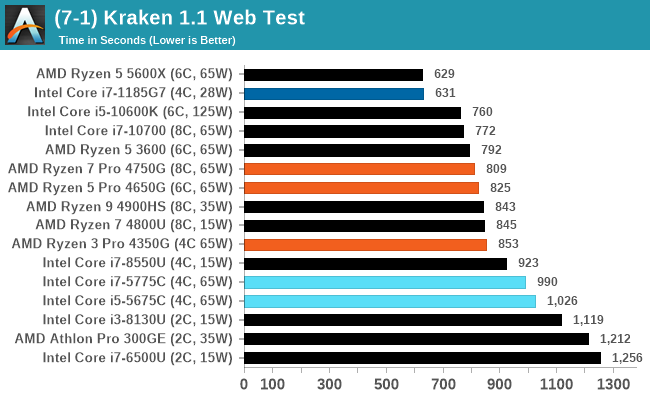
Google Octane 2.0
Our second web test is also JavaScript based, but uses a lot more variation of newer JS techniques, such as object-oriented programming, kernel simulation, object creation/destruction, garbage collection, array manipulations, compiler latency and code execution.

Speedometer 2: JavaScript Frameworks
Our newest web test is Speedometer 2, which is a test over a series of JavaScript frameworks to do three simple things: built a list, enable each item in the list, and remove the list. All the frameworks implement the same visual cues, but obviously apply them from different coding angles.
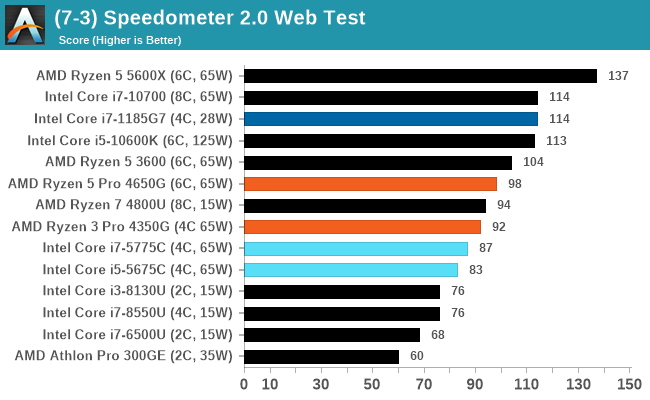










104 Comments
View All Comments
shady28 - Wednesday, December 16, 2020 - link
That's a big deflection. It only includes modern Intel CPUs on the *discrete GPU* tests. Given the title of the article it should have them in the regular iGPU tests. But that wouldn't fit the narrative nor the title now would it? This article needs to be pulled and re-written.Fulljack - Thursday, December 17, 2020 - link
@shady28 that's because Intel Gen 9 and 9.5 iGPU from Skylake and it's derivative are actually worse than Broadwell's Gen 8 iGPU with eDRAM. comparing it would be useless.Flunk - Wednesday, December 16, 2020 - link
If you want to split all the hairs, the M1 is an SoC. The difference being that an APU requires at least one other chip to function, the southbridge (theoretically, how you count "chips" here is somewhat up in the air) and an SoC doesn't.Fataliity - Wednesday, December 16, 2020 - link
Actually, Ryzen on desktop can run without the chipset. The chipset though adds more PCI-E lanes for nvme, etc. So only mITX (I think its an asrock board?) actually might go without the chipset.throAU - Tuesday, December 22, 2020 - link
To be fair, pretty much exactly nobody in the market for an AMD APU based machine is in the market for an M1 based machine at the moment.So whilst they're both processors including integrated graphics, they're totally different market segments.
bananaforscale - Wednesday, December 16, 2020 - link
Can you actually buy an M1 anywhere not soldered onto a Mac mobo? It can't be compared reliably because the platform is completely different, most tests would have to be run through emulation and so on.Frantisek - Sunday, December 20, 2020 - link
Understand and even agree but even in emulation those test would be interesting to see curent state of the art of Apple technology. Most games runs on M1 if not native or Roseta, then PC versions via CodeWeavers. And are playable.Frantisek - Sunday, December 20, 2020 - link
Checked Ex Deus and there is test showing it on M1 in custom 1080p setting with 25-34 fps.TheinsanegamerN - Wednesday, December 16, 2020 - link
No kidding. I mean what about the quallcomm 627 in my phone? Or the VIA chip in my netowrk controller? You cant have a comprehensive review without those!!!!Kuhar - Thursday, December 17, 2020 - link
ricebunny - you are a hoot! :) that`s what you are. ricefunny :)